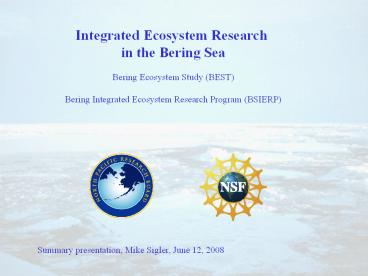Potential Climate Impacts on Fisheries - PowerPoint PPT Presentation
1 / 54
Title:
Potential Climate Impacts on Fisheries
Description:
Potential Climate Impacts on Fisheries – PowerPoint PPT presentation
Number of Views:43
Avg rating:3.0/5.0
Title: Potential Climate Impacts on Fisheries
1
Integrated Ecosystem Research in the Bering
Sea Bering Ecosystem Study (BEST) Bering
Integrated Ecosystem Research Program (BSIERP)
Summary presentation, Mike Sigler, June 12, 2008
2
Outline
- Bering Sea Importance
- Integrated Ecosystem Programs
- Understanding of the Bering Sea
- Understanding benefits stock assessments
J. Thedinga, AFSC
3
California fits into the Bering Sea
4
Alaska Feeds the Nation
5
Alaska Seafood Products
6
Protected, Endangered Threatened Species
Bearded seal
7
Subsistence Harvests
8
Tourism
9
Marine Transportation, oil and gas exploration
and production
http//geology.com/articles/northwest-passage.shtm
l
10
Phyllis
Bering Sea and Loss of Sea IceClimate Cold
Pool Extent
1982-1986
2002-2006
175
170
165
160
Temperature ( C)
Mueter Litzow (unpublished)
11
Climate Predictions from IPCC Analysis
Winter (NDJFM) Ocean Temperature Anomaly
(Relative to 1980-99 mean) IPCC A1B emissions
scenario
Prediction of minimum summer ice extent from
selected IPCC runs and actual ice extent (red)
Courtesy of J. Overland
12
Bering Sea Climate and Ecosystem Programs
13
Mike
14
Bering Sea Integrated Ecosystem Study (BSIERP)
and Bering Ecosystem Study (BEST)
Humans
Humpback and fin whales
Kittiwakes and murres, fur seals, walrus
Commercial/subsistence fish Pollock, cod,
arrowtooth flounder
Forage species Juvenile pollock,
capelin, myctophids
NPZ Infauna
Ichthyoplankton, Bivalves, euphausiids,
gastropods, Copepods polychaetes
Atmosphere/ocean
Climate Scenarios
15
Bering Sea Understanding
16
Ice, Wind, Bloom and Copepods
Early Ice Retreat Late Bloom, Warm
Water Large Copepod Biomass
Late Ice Retreat Early Bloom, Cold
Water Small Copepod Biomass
Hunt et al. 2002
17
Summer Copepod Abundance
Warm years
(Smith Vidal, 1986)
Courtesy of Napp and Shiga
18
Continued production in summer and fall important
Winds renew nutrients depleted by spring bloom
19
Young-of-the-year pollock abundance, BASIS survey
Mike
Cold, 2006-2007
Warm, 2004-2005
Small fish but fat. Big zooplankton, euphausiids
Big fish, but not fat. Cannibalism, small
zooplankton.
20
Recent weak year classes
Warm, low zooplankton
Cold
21
Competition between piscivorous fish, fur seals,
murres and kittiwakes for forage fish
22
Trophic interactions
Arrowtooth flounder abundance is increasing in
the Bering Sea
- Piscivorous fish, birds and seals
- Planktivorous fish and whales
23
Competition between forage fish and baleen whales
for zooplankton
24
Location Matters - Place-based foragers
25
People
- Local and Traditional Knowledge
- Fishermen (economics)
M. Sigler, AFSC
26
VERTICALLY-INTEGRATED MODEL
Only first-named PI is listed with project
title remaining PIs listed in note (e.g. s9).
Haynie. Economic and spatial fishery predictions
Irons. Seabird telemetry
Lauth. Bottom trawl survey
Farley. Surface trawl survey
Kultez. Seabird broad-scale
Wilson. Acoustic survey
Byrd. Seabird colony-based
Horne. Surface trawl survey acoustics
Kitasky. Seabird stress
Aydin. Upper trophic level (FEAST)
Ciannelli. Pollock and cod distribution
Friday. Whale broad-scale
Aydin. Functional foraging response
Trites. Fur seal telemetry
Wilson. Forage distribution
Ream. Fur seal colony
Sigler. Hot spot persistence
Benoit-Bird. Patch dynamics
Jay. Walrus telemetry
Heintz. Seasonal bioenergetics
Hillgruber. Ichthyoplankton surveys
Harvey. Euphausiids
Grebmeier. Benthic epifauna
Gibson. Lower trophic level (NPZ)
Sherrs. Zooplankton
Grebmeier. Benthic infauna
Moran. Primary production
Gradinger. Ice algae
Stoecker. Microzooplankton
Coyle. Mesozooplankton
Stabeno. Biophysical moorings
Hollowed. Ocean conditions
Moran. Carbon export
Hermann. Spatial ocean (ROMS)
Weingartner. Ocean conditions
Devol. Sediment nutrient flux
Sonnerup. Ocean conditions
Wu. Iron supply
Bond. Climate Downscaling.
Sambrotto. Nitrogen supply
27
Integrated Ecosystem Studies Not for the faint
hearted
28
Three Predictions Regarding Health and Function
of Ecosystem
For more informationhttp//bsierp.nprb.org/
29
BEST BSIERP Projects
30
Specific Studies (subset)
Picket fence of biophysical moorings
J. Napp, AFSC and P. Stabeno, PMEL
31
Seasonal Surveys
- Abundance, bioenergetics
- Biophysical moorings
- Ocean conditions
32
Standard NOAA Fisheries Surveys
33
Measure euphausiid abundance (Ressler and
deRobertis)
34
Ichthyoplankton Surveys (Hillgruber,
Duffy-Anderson, Napp, Matarese, Eisner)
- Walleye pollock, Pacific cod and arrowtooth
flounder - Distribution, abundance, and transport
35
USCGC Healy
Phyllis
36
Euphausiid growth, diet and demographics (Harvey,
Lessard, Pinchuk)
Animal collections in ice and open water (AT
NIGHT)
Potential Prey Copepods and nauplii, protists,
phytoplankton, detritus, ice algae
Biochemical Age estimation
Lipid Biomarkers
Shipboard Feeding Experiments (at night)
Demographic structure
Diet History Nutritional Status
Culture prey
Growth Rate and Egg Production
37
Sea Ice Algae abundance and production
(Gradinger, Bluhm, Iken)
38
Primary production and export to benthos (Moran,
Lomas)
Key - Diatoms, Zooplankton, Flagellates
39
Effects of benthic macrofauna on nitrogen cycling
(Shull and Devol)
40
Seabird broad scale surveys (Kuletz)
41
Cetacean broad scale surveys (Friday, Moore,
Zerbini, Clapham)
N89 CV0.68
N41 CV0.53
42
- COLONY TELEMETRY STUDIES (Byrd, Irons, Roby)
- Reproductive success (e.g. chick growth,
fledging weight, fledging success) - At sea foraging locations and forage trip
duration
43
Patch Dynamics Study - Pribilof and Bogoslof
Islands (Trites, Kitasky, Benoit-Bird, Heppel)
Satellite tags, diet and prey
44
Patch dynamics St. Lawrence Island (Jay and
Grebmeier)
Walrus - satellite tags, diet and prey
45
LTK communities (Huntington et al.)
- Harvest surveys
- Interview knowledgeable elders
- Community view of ecosystem
46
Approach Testing a priori hypothesesHypotheses
-gt Conceptual model -gt Statistical model
Retrospective Analyses (Mueter and Kruse)
Timing of bloom
Wind mixing
Pollock survival
Summer entrainment
47
Benefits of Understanding Climate and Ecosystem
Links through an Integrated Ecosystem Program-
Stock assessment and quota recommendations-
Location matters
48
Bering Sea Pollock Year Class Strength
49
Bering Sea Pollock Biomass
Quota dropped 30
Spawning exploitation rate
Prey for predators
Understanding recruitment decline
50
Wilderbuer et al. 2002, Prog. Oceanogr. 55235-246
51
Age -0 Pollock
Age 1 Pollock
Age 1 pollock
Location matters Climate impacts on spatial
distribution and niche partitioning?
Capelin
Age 0 pollock
52
Location Matters - Place-based foragers
53
Three Predictions Regarding Health and Function
of Ecosystem
54
- For more information
- Bering Sea Integrated Ecosystem Research
Program/Bering Ecosystem Study (BSIERP/BEST)
funded by the North Pacific Research Board and
the National Science Foundation -
http//bsierp.nprb.org/





























